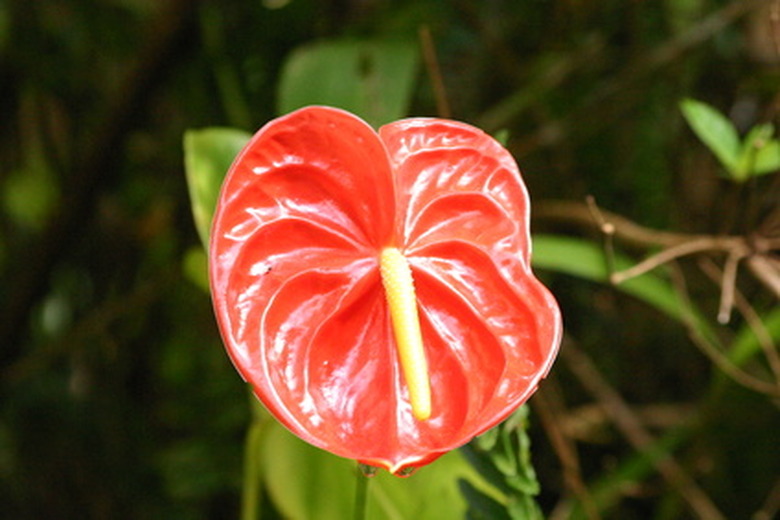How To Propagate Anthurium
We may receive a commission on purchases made from links.
The red, pink, yellow, white or variegated spathes of the anthurium (Anthurium spp.), also known as the flamingo flower, provide tropical color to your indoor garden. The colorful "flower" is actually a modified leaf, or spathe, and the yellow spadix that rises above the spathe is covered with its tiny flowers. To share your plant, you can propagate anthurium by division, by cuttings or, less often, by sprouting its seeds. A native of Central and South American rain forests, the anthurium is hardy only in U.S. Department of Agriculture plant hardiness zones 10 through 12.
Safety First With Anthurium
Safety First With Anthurium
All parts of your anthurium can irritate your eyes and skin, so put on a mask or safety goggles, gloves, and other safety gear before taking cuttings, pruning or repotting the plant. Anthurium contains calcium oxalate crystals, which cause severe pain and swelling of the mouth and digestive system if chewed or eaten. Keep it out of the reach of children and pets.
Sterilize all cutting tools by dipping the blades in rubbing alcohol. You can also use a rag soaked in the alcohol to wipe the blades between cuts.
In addition, clean used flowerpots by scrubbing to remove caked-on soil. Soak in a bleach solution of one part bleach to nine parts water for at least 10 to 15 minutes to kill any pathogens. Rinse and then scrub with dishwashing detergent and hot water before allowing it to air dry. If the pot is still stained, consider soaking it in a solution of equal parts vinegar and water and then rewashing it with soap and water.
Propagate Anthurium With Cuttings
Propagate Anthurium With Cuttings
Take a cutting with at least two nodes on the stem, preferably in spring or early summer. Dust the cut end with a fungicide and then insert it into sterile potting mix with one node under the mix. Water and then put the pot and cutting into a plastic bag to increase humidity around the foliage. Place it in a warm location with bright, filtered light and water as needed to keep the potting mix moist but not waterlogged.
In four to five weeks, the cutting should produce new growth. Repot into a mix of peat moss, bark and perlite or combine equal parts cactus mix and orchid mix to make a quick-draining potting mix suited to these tropical epiphytes. Water when the soil is dry to the touch and mist the foliage regularly. Don't let the pot sit in water, as the roots will rot.
Divide the Anthurium Plant
Divide the Anthurium Plant
Plants with multiple stems can be divided. Carefully slide the plant out of the pot and then divide it into two or more sections, each with foliage and roots. Dust the roots and any cuts with fungicide, as anthuriums are susceptible to fungal infections and root rot. Repot each section in fresh potting mix.
Reproduce With Seeds
Reproduce With Seeds
Anthurium seeds are less common since the bright-yellow flowers on the spadix produce pollen and are receptive to fertilization at different times. If you have multiple flowers on one plant or on several different plants, you can use a paintbrush to collect the pollen from one and spread it over the flowers on the other spadix. It can take up to a year for the anthurium to produce its tiny seed-bearing berries.
When the berries are ready to fall off the spadix, collect them and squeeze the tiny fruits to reveal the seeds. Sow the seeds and any remaining bits of the berry in moist vermiculite or peat moss. Barely cover the seeds and then set the pots or seed-starting tray on a seed heat mat. Mist lightly and cover with plastic wrap or other clear covering to keep the seeds warm and moist.
After the seeds germinate in five to 14 days depending on the temperature and species, keep the seedlings in a warm, brightly lit location. Transplant to larger containers when they begin to outgrow their pots. Water regularly and mist as needed to keep the humidity high.
